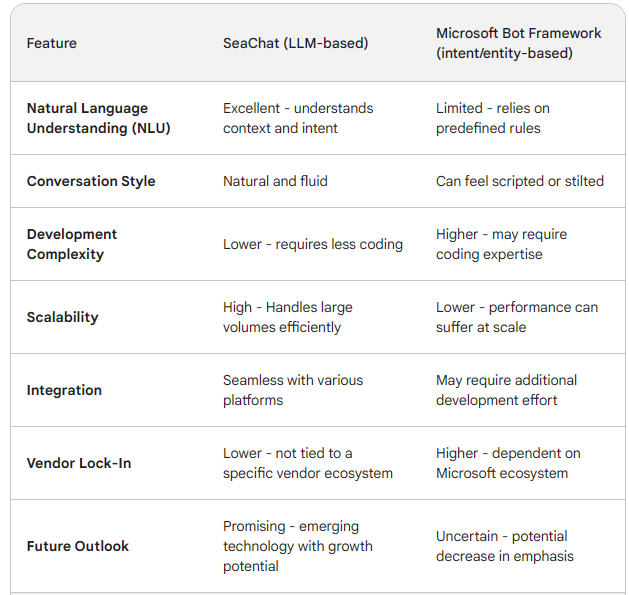The world of Conversational AI is abuzz with the recent news of Microsoft’s deepening partnership with OpenAI. While some celebrate the potential of this alliance, there are murmurs of discontent within Microsoft itself. Insiders reportedly fear a de-emphasis on internal AI development in favor of promoting OpenAI’s offerings.
One area specifically mentioned is the fate of Microsoft’s Azure Bot Service. Internal sources suggest it may be “more or less gone,” replaced by OpenAI solutions.
Microsoft Bot Framework and Azure AI Bot Service (and also LUIS.ai) are a collection of libraries, tools, and services that let you build, test, deploy, and manage intelligent bots. However, the GitHub repo for Bot Framework SDK has not been updated for more than 2 years (as of 2024) except the README:

What are developers’ alternatives for Microsoft Bot Framework?
Enter SeaChat: The LLM Challenger
While Microsoft ponders its AI strategy, Seasalt.ai is making waves with its LLM (Large Language Model) powered conversational platform, SeaChat. SeaChat utilizes the latest advancements in natural language understanding, offering a more natural and intuitive user experience compared to traditional rule-based chatbots.
Here’s why SeaChat may be well-positioned to lead the Conversational AI revolution:
- LLM Power: Leverages the power of LLMs, fostering more nuanced conversations. Understands context and intent with greater accuracy. Enables more natural and fluid user interactions.
- Flexibility: Adapts and learns as it interacts with users. Continuously improves its ability to provide relevant and helpful responses. Can handle complex queries and requests over time.
- Seamless Integration: Integrates seamlessly with various platforms and applications. Makes it easy to deploy chatbots across diverse channels. Offers omnichannel support for a unified customer experience.
- Reduced Development Time: Build complex chatbots faster with minimal coding required.
- Cost-Effective: Eliminates the need for extensive training data and resources.
- Scalability: Easily handle high volumes of inquiries without sacrificing performance.
Disadvantages of Azure Bot Services and Microsoft Bot Framework
While Azure Bot Services and Microsoft Bot Framework have served a purpose, they come with some drawbacks:
- Rule-Based Limitations: Relying on pre-defined rules can lead to stilted conversations and difficulty handling unexpected user inputs.
- Development Complexity: Building and maintaining complex chatbots can require significant coding expertise.
- Limited Scalability: Managing high volumes of inquiries can become a challenge, impacting performance.
- Integration Challenges: Integrating with various platforms might require additional development effort.
- Vendor Lock-In: Dependence on Microsoft’s ecosystem can limit flexibility and future options.
- Uncertain Future with OpenAI: Microsoft’s shift towards OpenAI solutions creates uncertainty about the long-term support for Bot Framework.
Traditional intent/entity based NLU vs. LLM-based NLU
Study has shown the difference of intent/entity based NLU vs. LLM-based NLU is in the millions. In terms of training examples, it’s 630,000 examples versus a mere 32. This dramatic reduction in training data requirements translates to significant cost savings for businesses adopting GenAI/LLM-based NLU.
SeaChat vs. Microsoft Bot Framework

SeaChat represents a significant advancement in the field of conversational AI, offering businesses a powerful and versatile platform for creating engaging and personalized conversational experiences. With its advanced technology, seamless integration, and comprehensive feature set, SeaChat stands as a compelling alternative to traditional frameworks like Azure Bot Services and Microsoft Bot Framework, paving the way for the future of AI-driven interactions.


 Subscribe
Subscribe